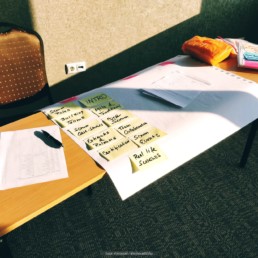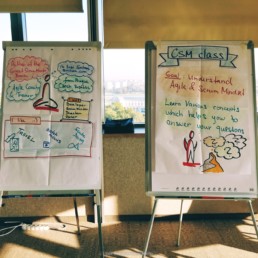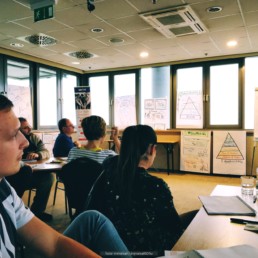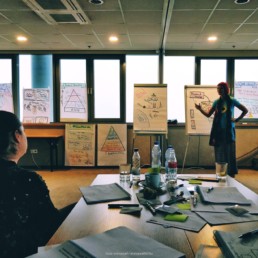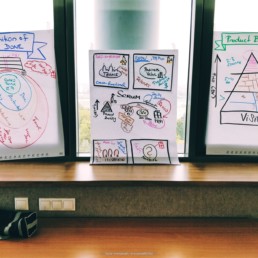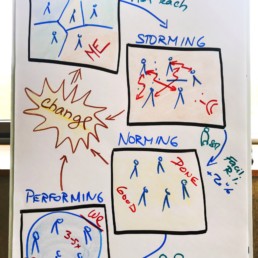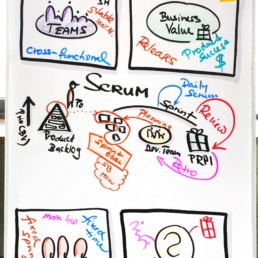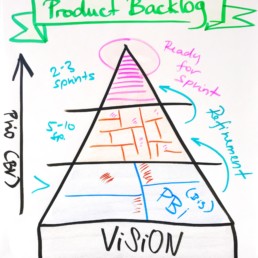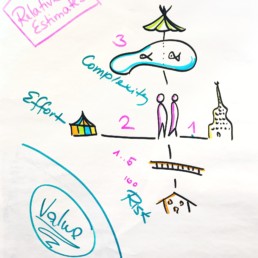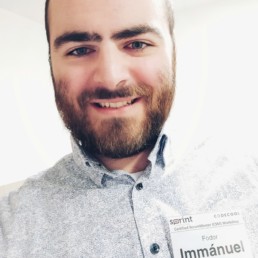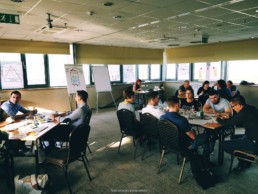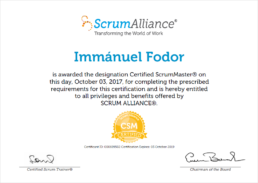I went to a Certified ScrumMaster training a few weeks ago then successfully passed the exam. Here are my story and review of the journey.
This article is the very first English post on my blog. I chose to publish it in this language as I intend to send the link to my fellow mentors at Codecool. Writing a review from every paid training we go to is a requirement to pass on the knowledge and experiences. Recommending or dissuading some training for the others can help us spend our educational budget wisely. The post could be internal only, but I decided to share it publicly to encourage companies and you too to invest in self-development.
Educational budget
Yeah, we have such, fortunately. At the end of the previous post about university studies vs. Codecool, I have mentioned (in Hungarian) that it is great to be a full-time mentor here. The educational budget is one of our benefits. These funds support mentors to improve themselves regularly by deepening or widening our knowledge. Are you a C++ oriented mentor with years of proven experience? You can go to specialized training for C++ developers – or you can choose any other one (for example some soft-skill oriented) to widen your perspective and develop other parts of your mind as well.
We established the educational budget after we have received the PortfoLion investment. To track our spending for the expense of this wallet, we have a shared spreadsheet where everyone must add a new row for any training they go to. As we could easily spend an infinite amount of money on learning ( 🙂 ), the budget is hard-capped for every year, and we have some rules that also apply. One requirement is a review of the training after completing it, as I mentioned before. Another is that we must introduce it to our fellow mentors in our team before making any step further. We can only go if they accept it based on our available time, the value it adds to the organization, and it should be in connection with IT. No, you cannot go to a nail technician training, yet! 🙂
I saw a couple of months ago that we had not spent any of our 2017 budgets, so I introduced my team the idea of me becoming a Certified ScrumMaster. I have seen CSM courses for years, but it always felt a bit too pricey for a personal purchase. The proposal was backed up by several facts why it is worth it for Codecool this time. I have Project Management experience primarily, and this new role could fit in my professional career well, transitioning from regular project management to an agile role. The ScrumMaster mainly cares for people and their relationships on several organizational levels, and as I have primarily dealt with product development until now, it is time to put my focus on people. We also teach the Scrum framework to our students, and it would be desirable to have an in-house CSM as proof that we indeed know it. It adds not only PR value but also the possibility to enhance our toolset and the way of teaching or doing Scrum. What I get to know, the students and the company will benefit from it eventually. There is also a PO (ProductOwner) role in Scrum, and it has its certification process too, but it is about the product they build. We are students’ mentors now, so it was out of the question which was the better choice from this perspective. My team accepted the proposal; our management approved it, and I signed up.
Training days
We have spent two days from 9 to 5 on the topmost floor of a hotel in a conference room with beautiful view to the underlying city. Food and drinks, as well as lunch, were provided by the organizer company, so we did not have any lack of anything, we could focus on learning.
Our trainer was Zuzi Sochova from Prague. She travels a lot from training to training, a real international lady. She has been practicing Agile/Scrum for ages, also educating it from half that time, if somebody knows what it takes to be a ScrumMaster, then she is. I have possibly never seen a more colorful person than her, from the hair through the clothes to the whiteboard markers she used and the artistic illustrations she created on-the-fly; everything was fresh and vivid.
About fifteen attendees were doing the course, most of them mainly arrived from big software companies. Already ScrumMasters going for the certificate, Software Developers and Project Managers wanting to become ScrumMasters, and many other ones interested in Scrum, including me. At first, we were separate entities in the same room coming from different environments, but then we started to get to know each other and had great conversations finally. Activities through the days encouraged forming and building up teams that can solve problems and discuss ideas efficiently, and we did great, I think, most of us would have even stayed for a couple of days more. I have also become friends with someone who was interested in Codecool and later came to look around and talk to us about what we do and how we could join our forces.
The CSM exam
After the two days, I spent one day with work, then one day with looking through my notes and the materials we have been given online to prepare for the exam. On the next morning, early before you were even woken up, I opened up my browser and went for the online test. It is built up by 35 multiple choice questions, and you have to choose the best fit for every problem. That means there are times when all the answers are right, but only one fits the question best, tricky. The feedback is instant after you submit your solutions, and I passed it, woohoo!
Takeaways
Of course, I could write lots of things about Scrum or the ScrumMaster role in general, yet I have other opinions to share with you, and you may also find these thoughts more interesting.
ScrumMasters should work on various levels in the organization. The first level is his/her team; the 2nd is their relations with other teams and departments, and the 3rd is the entire system. When reaching the last level, the SM becomes a servant leader. This statement grabbed me, as we have a guy who was and is a fellow mentor but he became a servant leader for us in the student and mentor education field. I had not recognized this concept is in parallel with Scrum until the training.
The previous point implies that a “career path” exists for SMs, too. Until now, I somehow thought that if you become an SM, then you are “locked” in the position but those levels bring more perspective into the picture. Moreover, other courses cover those parts, too: Advanced ScrumMaster, Agile Leadership, Management 3.0, and so on. You can always learn new things!
At the first lunch, I was sitting with developers, and when they asked about my work, I could tell them what I do, what we do, how and why. The “regular” 2-4 minutes long pitch worked, they saw the opportunity and liked the idea. On the other hand, the second day, I sat with some executive managers and my previous introduction did not go through. It is a typical picture that executives do not have much time, and I also felt that as I could not “sell” them the idea in the first 30 seconds, they lost interest, and their thoughts moved on. It seems the executive mindset needs a different sales technique that puts the “future profit” in correlation with money instead of people. 🙂 You usually focus on why it is worth for somebody to come to Codecool to start over his or her career as Software Developer when you talk with somebody, but when you discuss it with business people, you must concentrate on why it is worth for them or the company to hire Codecoolers. If you do not know what background they have whom you are conversing with, a clarification question can help you a lot to choose the correct angle of the same topic when doing ambassador work towards different positions in a mixed environment like this training was.
While many Codecool mentors are similar to ScrumMasters, those who want to be ScrumMasters need to be like Codecool mentors. It was an exciting find while looking at the other participants of the CSM course. They need to establish the mindset what mentors (already) have. While somebody becomes a mentor at our place and does our internal training sessions, he/she does not know what unique features are being built up in their mind. 🙂
It is not enough to state in a few points in the mentor job description that we offer exceptional atmosphere, we should communicate it clearly and extensively what an agile-approach culture we have. We could likely reach more mentor candidates coming from enterprise environment who would like to leave that lifestyle behind and work for an inspiring company. We can be proud how we operate, so culture marketing FTW!
ScrumMasters should know or educate themselves about ProductOwner responsibilities and how their role works, what are their priorities, motives, and so on. A previous knowledge of what the goals of the Development Team are also an advantage. These experiences can guide the SM to help the PO and the DT efficiently and avoid many impediments that otherwise he/she would bump into. I was pretty relieved after I had heard this, it reinforced my drifting to a kind-of people management role after gaining a solid technical background. Fun fact: you probably do not know that before becoming a “traditional” PM at my previous workplace, Mito, I played with the thought of being a PO at another company. Then it turned out that agile can wait a couple more years for me, and here I am, a CSM. Wow, I could not imagine that life story before!
Zuzi told a story about a company that went sideways for some time and then it suddenly turned to be a success. In the meantime, they offered everyone a package for leaving, half-year salary to be exact. 30% of the employees quitted suddenly. However, those who stayed became high-performing, worked together well, and so the company started to thrive without any “anchors” to hold it back. It is slightly unrelated to the whole training but I have never heard of such thing, and it was quite surprising.
About the CSM course
In my point of view, the course was mostly an Agile culture training (60%) wrapped into Scrum (40%), I felt most of the time that I am at an internal workshop with our private coach and organizational development expert. For those, who came from an enterprise background, thinking in an agile way was presumably a significant change but for someone coming from the same culture, it was not that hard. In fact, we have covered many topics already, so I even knew the answers by heart to some of the questions arose at the training. (E.g., the five dysfunctions of a team or the stages of group development, and so on.) We are teaching Scrum to our students, so the artifacts and roles were also no surprises. My feelings about this course is a bit ambivalent after all this, but I must state that only because that I am a mentor now. We already have the distinct knowledge fragments and the mindset that were introduced at the training, it was a big summarization and organization of the bits and pieces into alignment around a theme, the ScrumMaster role. For me, there were 20-25% information and topics that I found new and challenging. I asked a question to Zuzi that if I was here and receive the certificate then, am I indeed a ScrumMaster? Is that all, now I can help any teams perform (well or better)? She said basically yes, that is it. Although this training shows the way, it is our responsibility what to do next, preferably read and learn more (especially coaching and facilitation), explore case studies, and try to get as much hands-on experience as possible. I love that I can use the CSM title from now on, but I do not think for a moment that I am “done” with this by holding the title, I am going to do my best to grow fully into it.
Final thoughts
Well, I am now a full-time mentor, a Certified ScrumMaster, a former Technical Project Manager and Development Team Lead, a hobby photographer, an audiophile and even a blockchain enthusiast. The question is legitimate: am I a polyhistor or something? What my primary profession is? 🙂 I think these all topics are what makes me – me. I see myself slowly transition from product-focus to people-focus, and until I enjoy what I do, I try to continue my journey on this path.
Thank you for reading this long post! If you enjoyed it, you could show your love with clicking the heart below 😉







